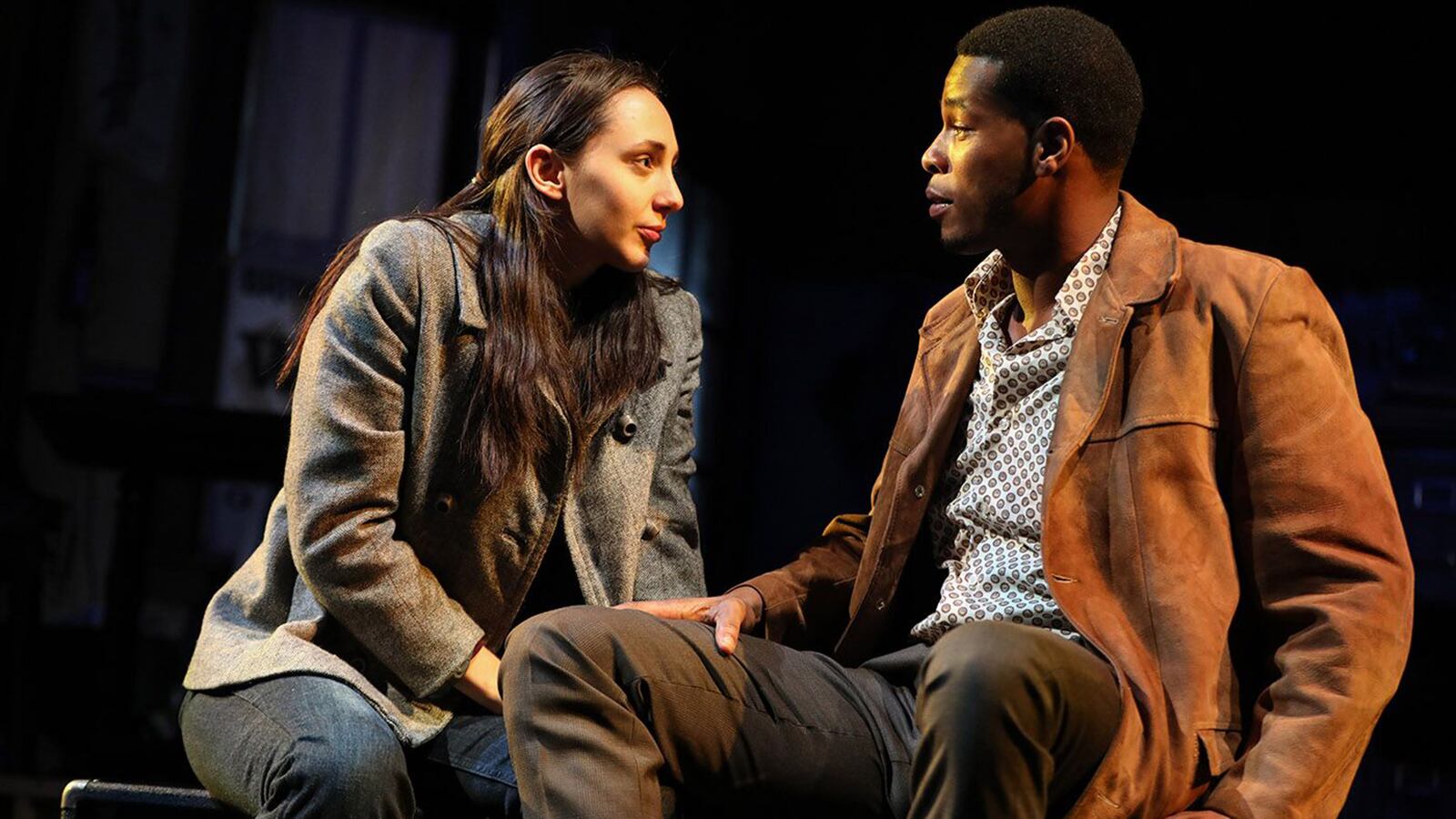Welcome to Ithaca, October 1969, where the young left-wing activists Spence (Mike Faist), Jenny (Lauren Patton), and Quinn (Odessa Young) are sharing beds and beliefs in a big, tattily furnished house full of protest signs against the Vietnam War. Two of their group, the unseen Jeff and Richard, have mysteriously disappeared with the group’s car.
This was an era when placards took time to make, and time to read. On one door we read: “A revolution is not a spectacle. There are no spectators. Everyone participates whether they know it or not.” Elsewhere are banners reading “Vietnam for the Vietnamese,” and “Not One More Day. U.S. Out Now.”
Louisa Thompson’s design looks like the slice of a doll’s house, and director Trip Cullman keeps us visually engaged with the conceit of seeing both upstairs and downstairs of this hive of righteous polemicizing.
It looks all very boho-chic and, as Steven Levenson’s script for Days of Rage, lays out this is “two months after Woodstock, seven months after My Lai, and six-and-a-half years from the end of the Vietnam War.” When the characters leave to go out on the streets the massive house-set retreats a bit, and they sit on some speakers doubling as a park bench.
The opening scene of this play features Jenny handing out leaflets outside a Sears in support of the "Chicago 8" (Jerry Rubin, Abbie Hoffman, Tom Hayden, Rennie Davis, David Dellinger, John Froines, Bobby Seale, and Lee Weiner), who would eventually become the Chicago 7, charged with various crimes after protesting the 1968 Democratic National Convention.
The ‘Days of Rage’ of the play’s title was the name for the anti-war demonstrations in Chicago, organized by the Students for a Democratic Society, that took place a year later in 1969, and which were hugely under-attended.
If we didn’t know it, we find that fact out in the best part of this underwhelming play: its epilogue. But the real-life Days of Rage’s shadow of futility and failure hangs over this group throughout.
“We’re done with protests,” Spence insists. “We’ve had enough candlelight vigils and sit-ins and meditating at the Pentagon. What has that accomplished?”
The play asks some familiar questions: what is the point of radicalism and direct action? What purpose does political idealism have? How liveable is it? It poses the questions in the narrative frame of a shambolic domestic milieu. Just as in the Stockard Channing-starring Apologia, the play’s 1960s radical-cultural ballast feels strangely secondary and reduced next to all the more conventional personal dramas.
These young people—dressed in very not-1960s clothing, which looks odd—want to do the right thing, they want to protest with all their hearts, but from what we see on stage you wouldn’t trust them with a basic supermarket shopping trip, much less bringing down the apparatus of the state.
The big questions the play poses feels wasted on these kids. Fast forward less than 20 years, you want to shout. Look at the energy and focus of AIDS group Act Up. See how effective, well-organized, and passionate good direct action can be.
Hal (J. Alphonse Nicholson) is not amused at all this privileged dicking around; he is black and works at Sears and has been told to eject the likes of Jenny from the sidewalk.
Later in the play, Hal, the most thought-out character in this tonally off-kilter play, will make clear how exasperating he finds all the whitesplaining the likes of Jenny do to his face, outlining all they know about racism and its effects, while he actually lives it and knows it more acutely than they ever will.
In one excellent moment, he drily responds to Jenny’s tales of anti-racist campaigning, “Thank you for helping us, I appreciate it.” She all too stoutly replies, the fiercely self-flagellating liberal, that she is a racist.
Still, they like each other, and Hal's gift of a pair of red gloves (on a Sears discount) to help keep Jenny warm when street-agitating got an “aww” from the audience this critic sat in.
Hal also has a brother in Vietnam, and not one who was drafted but who enlisted. He is horrified that the housemates have a Vietcong flag hanging in their living room. But Jenny defends herself: she has to do something. She is proud to be engaged, everybody should be; 25,000 people will attend the Days of Rage, she says.
Hal has to work to live. The young white agitants have the cushion of parental support, which they can fall back on if needs be (particularly Jenny). He feels strongly about social change, but he is also fighting personally for a stake in a society that Jenny and her fellow activists take for granted and don't see.
If Hal is the ideal roommate or partner, the grating Peggy (Tavi Gevinson) is the polar opposite. Anyone, except apparently this very stupid bunch, can see she is trouble at first glance. Gevinson does an excellent job of making Peggy thoroughly annoying from the first moment.
She is far too intense and focused when she approaches Spence on the street to get a room in the house, and far too critical and shrill and overtly sneaky in her mission to destroy the trio's house-share.
Is Peggy a more sinister saboteur? When Spence is followed and a mysterious car appears outside the house, her lies and the general paranoia of the group produce a situation that is both comic and potentially tragic. One particular moment has almost the entire audience (at least the night this critic attended) suddenly ducking in terror.
It is Peggy’s presence and her machinations, and Gevinson’s fury, that takes Days of Rage well away from politically themed drama into the melodramatic and comic. The characters’ faults and vulnerabilities are centered not around their beliefs, but around their non-monogamy.
There is some brisk and well-executed comedy, particularly around Peggy, and a moment where “Lenin” is misheard” as “Lennon.” But Days of Rage is too slight to be searing political drama (we’ve heard all its sermonizing before) and too affectionate to its irritating characters to be a satire of their big words and sexual and romantic indiscretions.
But then there is that poignant postscript, with Quinn and Spence sitting overlooking Chicago, one night during the Days of Rage. This lovely piece of writing, beautifully acted by Faist and Young, keeps their characters in the present day of 1969, and then throws their lives and destinies forward, so we learn what happened to them.
A stronger play might have woven that time-traveling fabric into its main structure, to emphasize the gap between ideals and outcomes, both personal and political. Instead, this piercing epilogue shows—in line with what activists of that time often invoke—what might have been.
Days of Rage is at the Tony Kiser Theater, 305 West 43rd Street, NYC, until November 25.






